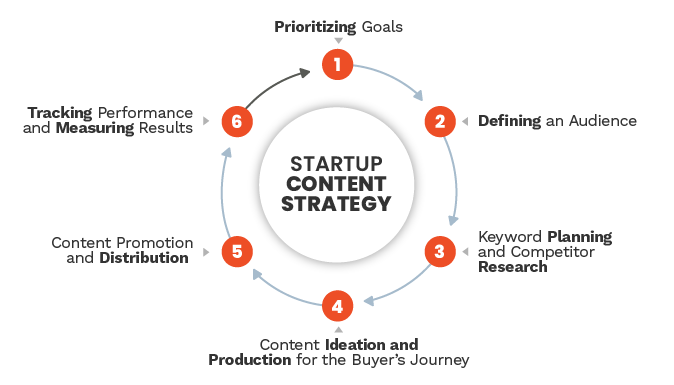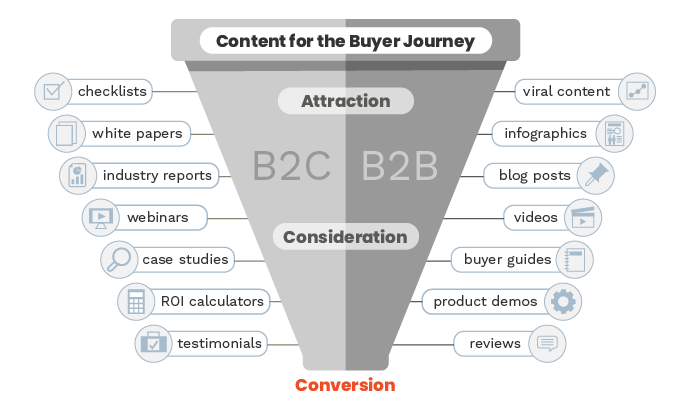Email marketing, public relations, social media, referral marketing, influencer and affiliate marketing, search engine optimization – there are a lot of moving parts when it comes to implementing a holistic startup marketing strategy primed for growth.
While every startup strives for similar goals, depending on the business, the priority of goals can vary. There’s no one-size-fits-all marketing strategy for new companies.
There is, however, a formula for creating the ideal strategy to meet your startup goals. It may seem overwhelming at first, but crafting a startup marketing strategy boils down to a six-step cycle.
Being a startup ourselves, we know firsthand how a solid content strategy is the foundation of a growing business, but we also understand how difficult it can be to create one from scratch.
So we want to walk you through the cycle step by step.
Prioritizing Goals and Objectives for a Startup Marketing Strategy
Content marketing can achieve various goals, which is why it’s such a great, cost-effective option for startup marketers with limited budgets.
While there are several lesser-known benefits of content marketing, these are four common goals marketers strive to achieve based on our own experience after speaking with clients and industry peers:
Different goals require different keywords and content (more on that below), so it’s important to have your goals prioritized to guide your strategy from the very start.
Ultimately, whether the goal of your content is to build high-authority links or convert prospects, in one way or another the focus of your content should be to build a relationship with your audience. But who is your audience?
Defining Audiences
For startups especially, marketing to too broad of an audience will waste time and money – you’re almost guaranteed to get lost in the noise. Defining a niche market and creating content of value and interest to that specific audience is the key to getting your startup off of the ground.
What factors should you consider when defining an audience?
- Audience Size
- How many variables of your ideal customer or client can you identify to narrow the size of your audience? Can you specify by their location, demographics, motivations, and needs to better target your efforts?
- Market Competition
- How saturated is the market for your product or service? Will you be filling a void or are you facing stiff competition from established brands?
- Unique Value Proposition
- What makes your startup’s product or services stand out from your competitors? Are you the cheapest, most proficient, or the highest quality?
- What makes your startup’s content stand out from your competitors? Is it your brand’s unique voice, your exclusive research and internal data, or audience engagement?
These should look familiar as they are factors your startup should already consider when segmenting your market, which will help keep your marketing and sales teams on the same page.
Keyword Planning and Competitor Research
Keyword planning allows you to better understand your audience and communicate with them more effectively by providing strategic content serving their search queries. For startups, a great way to start is by performing a keyword analysis on competitor websites to gain strategic SEO direction for your own content strategy.
While keyword research may seem like an intimidating task best left for SEO experts, various resources like Alexa’s SEO tools and Google’s Keyword Planner exist to help your startup:
Identifying content gaps allow your startup to take advantage of missed opportunities and create content your audience is searching for but can’t seem to find.
Creating content matched to user intent will significantly help increase and retain your organic search traffic. Since users in each stage of the buyer’s journey will be using different keywords in their queries, your keyword planning can go one step further.
Mapping keywords relative to the buyer’s journey will help better tailor content for different stages of the marketing and sales funnel – which in turn makes it easier to relate keyword and content opportunities to milestones your sales team may already be familiar with.
For example, buyers in the awareness stage will typically use informational keywords, which by definition are queries that cover a broad topic seeking answers or guidance and may include “how to” or “tips for” keywords.
Those same buyers further along in their journey at the consideration stage may already be familiar with your brand and may use navigational keywords, which are intended of finding a particular website or brand.
Those ready to convert, however, are more likely to use transactional keywords like “buy” or “order” as they are seeking to complete a purchase.
Content Ideation and Production for the Buyer’s Journey
Now comes the fun part: ideation.
Keep the details of your ideal audiences and the keywords identified at the forefront of your mind while recognizing which stage of the buyer’s journey each idea can target.
Organize your brainstorming sessions by creating an editorial calendar that outlines a publishing schedule with the following for each piece of content:
- Format: Will this be on-site or off-site? Specify if it will be a blog post, white paper, buyer guide, research campaign, industry report, video, infographic, etc.
- Keyword: Which keyword from your analysis should be the focus of this post? What would be related keywords or long-tail keywords? Is it informational or transactional?
- Title and Topic: Give a title and description of the main topic. Both should focus heavily on the keyword(s) chosen. Give an overview or thesis with any potential data sources or examples to help guide the content writer.
- Goal: Specify which stage of the buyer’s journey and the related goal this piece of content strives to achieve.
The frequency and amount of content your startup publishes depends significantly on your manpower, but luckily most content strategists agree to put more emphasis on quality rather than quantity.
Tailoring to B2C and B2B Audiences
While their journeys follow a similar path of attraction, consideration, and conversion, B2C and B2B audiences have different needs and expectations for content.
Consumers are searching for entertainment that speaks to their emotions and insights for more impulsive buying decisions, while businesses are looking for expert advice and professional resources.
Regardless of the industry, however, B2C and B2B brands usually share those four top-level goals.
While it’s possible to repurpose content for those goals like building brand awareness or converting leads, the format of the content you produce will depend heavily on whether your brand identifies as B2C or B2B and which part of the buyer’s journey in the sales funnel you’re targeting.
B2C Content Formats
Top-of-the-funnel objectives should drive awareness and attraction.
In terms of off-site content for consumer brands to increase brand awareness, widely appealing campaigns primed for mass appeal and viral social sharing should be mixed with niche campaigns primed for targeted audiences.
Widely appealing campaigns have the potential to earn mass exposure and therefore build a diverse link portfolio, meaning your brand will see SEO benefits like increased search rankings for your domain overall.
As far as driving organic traffic, consider in-depth on-site content like educational how-to resources as well as more entertaining or timely content related to your product or services.
By utilizing your keyword research, these on-site content formats have the potential to rank high in search queries, attracting potential customers in the later stages of the journey to your site.
Buyer guides, product demos, and customer reviews are key forms of evergreen content that help convert buyers ready to make a purchasing decision.
Our case study for online sports retailer Fanatics reveals this mix of promotionally viable off-site campaigns and entertainingly educational on-site content proved to be a winning combination in growing their newly launched blog. In just six months, Fanatics saw a 1,100% increase in organic search traffic and a 230% increase in the number of ranking keywords.
B2B Content Formats
Like B2C, B2B brands can also benefit from a mix of broadly appealing and brand-specific research campaigns primed for off-site promotions, especially for achieving top-of-the-funnel attraction objectives like brand awareness.
The primary goal of these promotionally viable off-site, data-driven campaigns typically is to establish industry recognition as a thought leader, though the research can be repurposed into on-site content as well (more on that in a moment).
In terms of other off-site content, bylines and guest columns on niche industry publications and top business publications add tremendous value to a B2B brand in the form of thought leadership while also building valuable links.
Our Associate Director of Marketing Kerry Jones wrote the above guest post for Moz, a leader in the content marketing vertical. Her byline appearing there demonstrates that Fractl is also notable in the industry.
Bonus: With the potential to rank high for common search queries, on-site blog posts encompassing similar topics as off-site guest contributions also help increase organic traffic.
Content demonstrating your B2B brand’s expertise and results while also differentiating your brand from competitors can go way beyond a Forbes column or on-site blog post for those making their way to the consideration stage.
White papers, e-books, webinars, and interviews in the form of podcasts convey your brand’s industry expertise. When repurposing content, the subject matter can be inspired by the results of your data-driven campaigns.
As far as the leads making their way to the conversion stage, client testimonials and case studies persuade through social proof and actual results to help increase conversion rates.
B2B brands seem to struggle more than consumer brands with content ideation, but it’s clear a diversified content mix is a critical component to not only pushing leads through the sales funnel, but achieving other marketing goals like brand positioning.
Our case study for BuzzStream – an influencer marketing CRMl that streamlines outreach and PR tasks – illustrates how a well-planned content strategy helped position them as thought leaders and continues to provide long-term value to their brand.
Take a look at the results below.
Content Promotion and Distribution
Your content marketing strategy doesn’t stop after the blog post is live, the e-book is published, or the campaign is completed.
While the keyword research should help your content get found organically through search engines, promoting your content is crucial but often overlooked by startups. Limited resources or experience in facets of content marketing like social media, email marketing, and public relations shouldn’t be an excuse for failing to promote your content.
Regardless of your industry or who your brand is trying to reach, content promotion strategies at a high level are similar for both B2B and B2C brands – meaning all marketers should take similar approaches in distributing their content, namely through:
Posting and, more importantly, engaging on social media and building an email newsletter subscriber list are ways to distribute your content to an audience that has chosen to follow your brand.
In most cases, these audiences are well beyond the attraction stage, and many of them have already purchased or worked with your brand, making them more likely to be open to future transactions.
On the flip side, digital PR utilizes different outreach methods to earn media coverage, influencer advocacy, and even bylines that can grow that audience following your brand on social media or subscribing to your weekly e-newsletter.
Besides the ability to reach a broad to a hyper-specific target audience, the third-party sharing your content (whether it’s a publisher or influencer) has a pre-existing trust and established authority over a loyal audience. Further, digital PR can help with link building and referral traffic.
Measuring Results
One of the biggest challenges facing both B2B and B2C marketers is measuring the ROI of their content marketing strategy.
The volume and complexity of metrics to measure the results of your strategy can be overwhelming, especially when trying to tie back how specific metrics impact your bottom line.
Again, this is where your goals come into play – they will help you better identify which metrics are the most valuable to track.
For brand awareness and link-building objectives, visibility and engagement KPIs should be monitored closely. When it comes to goals tied to lead generation and attracting more customers, traffic and conversion KPIs help connect your content marketing to your leads and their movement through the sales funnel. Naturally, traffic KPIs also are important for tracking efforts tied to increasing organic traffic.
When measuring the results of specific campaigns or pieces of content, the type of content and its distribution channel will also impact which KPIs you will need to follow.
This post gives a detailed breakdown of each KPI for tracking the traffic, visibility, engagement, and conversion metrics for both on-site content and off-site campaigns.
Choosing the right metrics to track will help you understand not only how your content strategy is impacting your bottom line, but it will also help you assess the effectiveness of particular campaigns or content. This, in turn, will help better guide your next round of content ideation and production – focus on replicating successes while improving failures.
As the cycle continues, it’s important to reevaluate goals and ensure there aren’t any significant changes to your ideal audience or keywords.
Holistic content strategies go beyond a few blog posts and email newsletters, and while it may still seem overwhelming, the volume of content your startup produced can be scaled with your brand’s growth.
Regardless of the amount of content you produce, always be sure to keep your audience’s needs and wants as your top priority – great content and results will be sure to follow when you make the audience the focus of your startup marketing strategy.
















